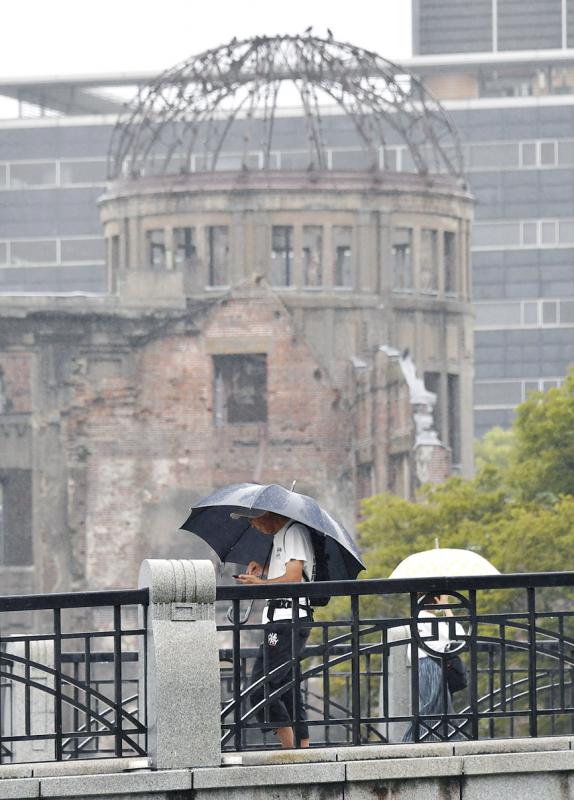Torrential rain pounding southwestern Japan yesterday triggered a mudslide that swallowed four people, and was threatening to cause flooding and more landslides in Nagasaki Prefecture and other regions.
The mudslide in Unzen hit two houses with four residents.
A woman in her 50s was pronounced dead, while a man in his 60s was seriously injured, city officials said.

Photo: REUTERS / Kyodo
Rescue workers were searching for the two other residents.
TV footage on public broadcaster NHK showed rivers in Hiroshima swollen with muddy water gushing down, almost overflowing.
The meteorological agency said that nearly 500mm of rain fell in parts of Nagasaki within 48 hours, exceeding the average for August.
More torrential rain was forecast.
Local authorities issued evacuation advisories to high-risk areas in those regions, affecting more than 3 million residents, but the measure is non-compulsory and a fraction usually evacuate.
“There is a possibility that a grave disaster will occur” in the coming days, a Japan Meteorological Agency official told an emergency news conference broadcast on NHK.
For Hiroshima, “we have issued a special heavy rain warning. This is a level of heavy rain that we have never experienced before,” the agency said in a statement, calling the rain in some areas “unprecedented.”
The agency said that in the 24 hours from 6am yesterday, 300mm of rain is expected in the northern part of the southern main island of Kyushu, with 200mm to 250mm forecast in many other parts of the country.
For Kyushu, it issued heavy rain and mudslide warnings.
Scientists say that climate change is intensifying the risk of heavy rain in Japan and elsewhere as a warmer atmosphere holds more water.
Downpours last month caused a devastating landslide in the central resort town of Atami that killed at least 21 people.
Additional reporting by AFP

WAITING GAME: The US has so far only offered a ‘best rate tariff,’ which officials assume is about 15 percent, the same as Japan, a person familiar with the matter said Taiwan and the US have completed “technical consultations” regarding tariffs and a finalized rate is expected to be released soon, Executive Yuan spokeswoman Michelle Lee (李慧芝) told a news conference yesterday, as a 90-day pause on US President Donald Trump’s “reciprocal” tariffs is set to expire today. The two countries have reached a “certain degree of consensus” on issues such as tariffs, nontariff trade barriers, trade facilitation, supply chain resilience and economic security, Lee said. They also discussed opportunities for cooperation, investment and procurement, she said. A joint statement is still being negotiated and would be released once the US government has made

Authorities have detained three former Taiwan Semiconductor Manufacturing Co (TMSC, 台積電) employees on suspicion of compromising classified technology used in making 2-nanometer chips, the Taiwan High Prosecutors’ Office said yesterday. Prosecutors are holding a former TSMC engineer surnamed Chen (陳) and two recently sacked TSMC engineers, including one person surnamed Wu (吳) in detention with restricted communication, following an investigation launched on July 25, a statement said. The announcement came a day after Nikkei Asia reported on the technology theft in an exclusive story, saying TSMC had fired two workers for contravening data rules on advanced chipmaking technology. Two-nanometer wafers are the most

NEW GEAR: On top of the new Tien Kung IV air defense missiles, the military is expected to place orders for a new combat vehicle next year for delivery in 2028 Mass production of Tien Kung IV (Sky Bow IV) missiles is expected to start next year, with plans to order 122 pods, the Ministry of National Defense’s (MND) latest list of regulated military material showed. The document said that the armed forces would obtain 46 pods of the air defense missiles next year and 76 pods the year after that. The Tien Kung IV is designed to intercept cruise missiles and ballistic missiles to an altitude of 70km, compared with the 60km maximum altitude achieved by the Missile Segment Enhancement variant of PAC-3 systems. A defense source said yesterday that the number of

Taiwanese exports to the US are to be subject to a 20 percent tariff starting on Thursday next week, according to an executive order signed by US President Donald Trump yesterday. The 20 percent levy was the same as the tariffs imposed on Vietnam, Sri Lanka and Bangladesh by Trump. It was higher than the tariffs imposed on Japan, South Korea and the EU (15 percent), as well as those on the Philippines (19 percent). A Taiwan official with knowledge of the matter said it is a "phased" tariff rate, and negotiations would continue. "Once negotiations conclude, Taiwan will obtain a better